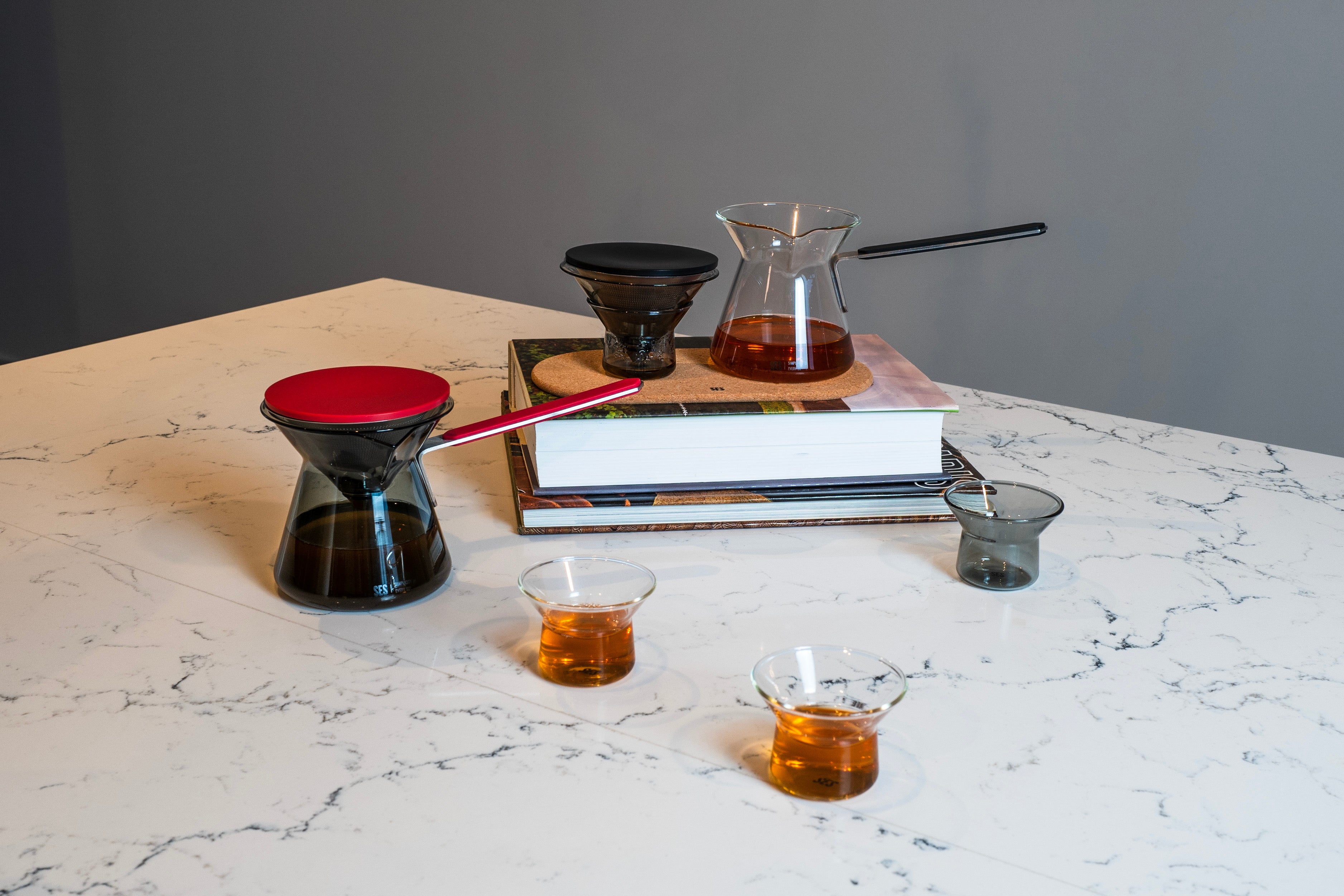White Tea
White tea is the least processed of all tea types, made from young tea buds and leaves that are simply withered and dried. Because it undergoes minimal oxidation, white tea maintains a delicate and light flavor profile. The leaves often have a silvery-white appearance due to fine downy hairs. Some of the most common white teas include Shoumei, Silver Needle, Gongmei, and White Peony.
Flavor Profile:
New White Tea:
- Aroma: New white tea can have a light, fruity, and slightly floral aroma. You may detect subtle hints of herbs, dried grass, or stone fruit.
- Taste: The flavor is sweet and smooth, with fruity notes that often resemble peach, apricot, or melon. It also carries a slight vegetal quality, similar to fresh hay or cucumber, while maintaining a mild sweetness.
Aged White Tea:
- Aroma: Aged white tea has a deeper, earthier, and more fruity aroma, with notes of dates, figs, or even a touch of raisin. You may also detect hints of wood, spices, or a slightly honeyed scent.
- Taste: The flavor of aged white tea is much more complex, with a rich sweetness that is reminiscent of dried fruit, such as plums or apples. There are also woody, nutty, and earthy undertones, giving it a more rounded and mature flavor. As it ages, the tea becomes more mellow and loses some of the fresh, grassy notes present in its youth.
Caffeine: White tea has a moderate caffeine content, typically ranging from around 15 to 30 milligrams of caffeine per cup (8 oz).
Green tea
Green tea is lightly processed, where the leaves are quickly steamed or pan-fired to prevent oxidation. This minimal processing helps retain its fresh, grassy flavors and green color. The tea leaves are typically harvested while still young and tender. Some of the most common green teas include Sencha, Xinyang Maojian, Longjing (Dragon Well), and Gyokuro. Green tea is best when enjoyed fresh as it losses flavor with time, thus it is recommonded to getting new green tea every year. Flavor profile:
- Aroma: Green tea typically has a fresh, grassy, and slightly vegetal aroma. You may detect subtle hints of seaweed, chestnut, or spring leaves.
- Taste: The flavor is light and refreshing, with vegetal notes that often resemble spinach, green beans, or fresh grass. Depending on the variety, it may also have subtle nutty or floral undertones, and occasionally a hint of citrus or sweet corn.
Caffeine: contains moderate caffeine, typically ranging from 20 to 45 milligrams per cup (8 oz)

Red tea
Known as Hong Cha in China, red tea is fully oxidized, resulting in a dark brew with a rich, malty flavor. Common varieties include Keemun, Dianhong, and Lapsang Souchong, which is famous for its smoky flavor.
Flavor Profile:
- Aroma: Red tea has a rich, malty, and sweet aroma, with hints of dried fruit, honey, and sometimes caramel. Depending on the variety, you might also detect notes of molasses or baked bread.
- Taste: The flavor is typically smooth and full-bodied, with natural sweetness and notes of dark fruits like raisins or plums. It may also have undertones of toffee, spice, or chocolate, creating a warm and comforting profile. Red tea is known for being less astringent than black tea, offering a smoother finish.

Black tea
Black tea undergoes full oxidation, giving it a dark color and bold, robust flavor. During processing, the tea leaves are rolled and allowed to fully oxidize, which converts natural catechins into tannins, resulting in its characteristic strong taste. Common varieties of black tea include Assam, Darjeeling, Earl Grey and Keemun. Flavor profile:
- Aroma: Black tea has a bold, malty, and sometimes smoky aroma. You may also notice hints of dried fruit, cocoa, or spices, depending on the variety.
- Taste: The flavor of black tea is typically full-bodied and robust, with notes of malt, chocolate, and dried fruit like dates or raisins. Some varieties, such as Lapsang Souchong, may also have a smoky flavor, while others like Darjeeling offer a lighter, more fruity and floral taste.
Caffeine: Black tea contains moderate to high caffeine, typically ranging from 40 to 70 milligrams per cup (8 oz)

Puerh Tea
Pu-erh tea is a fermented and aged tea, originating from Yunnan Province, China. The tea leaves undergo microbial fermentation and are often compressed into cakes or bricks. There are two main types of Pu-erh tea: Sheng (Raw) and Shou (Ripe). Over time, Pu-erh tea develops rich, earthy flavors, with aged versions being particularly prized. Flavor profile:
- Raw Pu-erh (Sheng):
- Aroma: Raw Pu-erh has a fresh, earthy, and slightly floral aroma, especially when young. Over time, the aroma deepens, developing subtle hints of moss, wood, and sometimes stone fruit or dried leaves.
- Taste: When young, Raw Pu-erh has a bright, crisp flavor with hints of green vegetables, herbs, and a slight bitterness, similar to green tea. As it ages, the flavor becomes more complex and mellow, with subtle sweetness and earthy notes emerging, often reminiscent of stone fruits, honey, or wet wood.

- Aroma: Ripe Pu-erh has a rich, earthy, and slightly musty aroma due to its fermentation process. You may also detect notes of wet earth, leather, mushrooms, and sometimes a faint hint of dark chocolate.
- Taste: Ripe Pu-erh is known for its smooth, deep flavor, with pronounced earthy notes and undertones of cocoa, dark fruit, or wood. It tends to be mellow with a naturally sweet aftertaste and lacks the bitterness found in young raw Pu-erh. As it ages, Ripe Pu-erh can develop more nuanced flavors, such as nuts or spices.

Oolong tea is partially oxidized, placing it between green and black tea in terms of processing and flavor. The degree of oxidation can range from light to heavy, resulting in a wide variety of flavors and aromas. Oolong teas are known for their floral and fruity notes. Popular oolong varieties include Tie Guan Yin, Da Hong Pao, and Milk Oolong.
- Aroma: Oolong tea offers a complex and varied aroma, depending on its oxidation level. Lightly oxidized oolongs have a floral, fresh, and sweet aroma, reminiscent of orchids or jasmine. More heavily oxidized oolongs tend to have toasty, fruity, or nutty aromas, sometimes with hints of caramel or stone fruits.
- Taste: The flavor of oolong tea varies widely based on oxidation. Lightly oxidized oolongs are floral, sweet, and refreshing, with notes of honeysuckle, peach, or gardenia. Heavily oxidized oolongs have a richer, more robust flavor, often featuring toasty, woody, or roasted notes, with hints of caramel, plum, or nutmeg. Oolong is known for its smooth texture and lingering aftertaste, often described as creamy or buttery.





Leave a comment
All comments are moderated before being published.
This site is protected by hCaptcha and the hCaptcha Privacy Policy and Terms of Service apply.